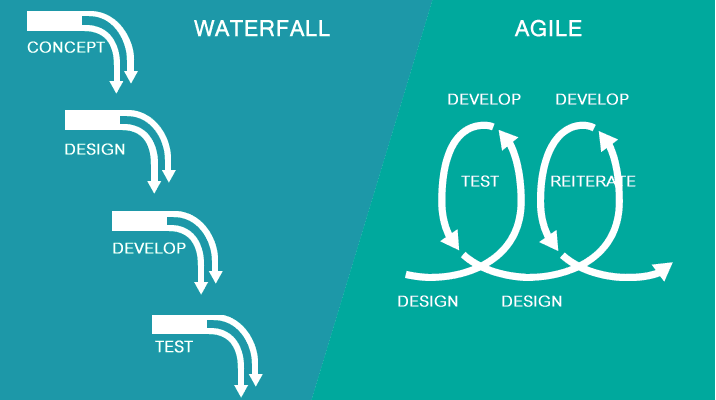
Agile project management is a hotly debated topic and has left some of us wondering “what’s so great about Agile?” and “what can it do for me?” Agile portfolios are trending right now, and it’s not a one-size-fits-all approach. As Agile popularity grows and demand for Agile teams increases, it is important to understand the benefits as well as the implications of running an Agile portfolio. First, though, we’ll cover some background on Waterfall and Agile.
What is Waterfall Project Management?
Waterfall project management, sometimes known as traditional project management, involves an in-depth upfront planning process and follows a linear, pre-determined project schedule over a period of time. Waterfall projects are typically predictable, have a definitive start and end date, and have an explicit process for execution. The advantages of using the Waterfall method to manage projects is having clear expectations and (hopefully) meeting those expectations by achieving certain milestones. Stakeholders know what they are going to get, and resources know what to give.
Waterfall originated in the construction/manufacturing industry as after-the-fact changes were often costly. A simple example of a Waterfall project is building a house. To build a house, one must first procure land, then build the foundation, then build the walls, then install the kitchen and bathroom appliances, etc. Each phase is accompanied by planning activities and one phase cannot be completed before the next phase (i.e., the kitchen appliances can’t be installed on the foundation). In the end, the plans are followed exactly, and you have the house exactly as it was in the drawing.
What is Agile Project Management?
Agile project management is an iterative approach that aims to deliver the highest value work possible within a limited amount of time. Often, Agile practitioners will mention sprints or releases, which are just lengths of time which a certain volume of work is to be delivered. Agile development often occurs when technology is changing, teams are changing, or the goal of the project is changing. The essential aim of Agile is to stay nimble and be able to adapt to changes rather than being forced to execute against a plan which may be obsolete. When planning an Agile project, understand that the process may be unsequential and the time frame could also be fluctuating as well. For exploratory projects, or projects that are long, Agile management can deliver quick wins and have success keeping on track as small iterations are evaluated at the end of each “sprint” or segment of the project.
If we go back to our house example, using Agile, we would ask the homeowner for feedback while we were building instead of investing so much time in our upfront planning. In this instance, the house may take longer to build or it may be completed in the same timeframe. However, if the foundation is not right or the homeowner suddenly wants to add a bedroom, you don’t have to start all over – you can work incrementally and ensure you are in alignment after each phase, even if the alignment changes course. Just as in our house example, the eventual outcome of Agile projects is less defined up front, but you are able to respond to change and incorporate customer feedback into the finished product.
So Which Project Management Method is Best?
The answer, of course, depends on the project and your own internal processes. When deciding what method to use within your PMO, evaluate your projects using these guiding questions:
Is the outcome defined?
It might help to think of this in terms of iteration as well. Have you done this before, and what are you expecting from this project? If you expect it to be “just like last time,” then a Waterfall approach could be a fitting choice. However, if you’re managing a new product development that has vague goals or is exploratory in nature, Agile could be helpful in accounting for changes, trying out new processes, discovery of technology limitations, or incorporating new ideas along the way.
Is the process well defined?
When deciding between Agile and Waterfall, it’s also important to think about whether the method for executing the project is well known and well defined, or if it is relatively unknown territory. The Waterfall method is most well suited to projects with a well defined scope and sequence of events for execution. For example, in the case of an infrastructure upgrade, the process to decommission an existing server and install a new server is very well known and has been completed successfully many times. The process to accomplish this is well known and defined this way for a reason: It works!
Alternatively, when the process for delivering the project is not well known, often an Agile approach is best. For example, software development projects are often difficult to scope, and several of the features that will be a part of the end product will be discovered during the iterative delivery process.
How high is the cost of failure?
When the costs of project failure are high, having a well thought out plan and a detailed scope is best. This lends itself well to a Waterfall project management method. For example, if there are very limited resources and no room for error, or the business is depending on the outcome, it is generally best to know what to expect and when to expect it up front.
Agile project management and iterative development often encourage failure- “If you fail, fail fast” is a mantra for some Agile teams. The thought process with Agile project management is to continue to iterate until the finished product is successful. If the cost of failure is small, failing and getting feedback about what doesn’t work can be helpful to identify what works, then continue the project with that feedback in mind.
Other Considerations:
Good Portfolio Planning is Essential to Good Project Execution
Regardless of Agile or Waterfall, organizations should implement a well defined project review and prioritization process to ensure that the organization is executing the highest value, most well aligned work items. Depending on the flexibility of scope, room for agility should be accounted for as much as possible.
Don’t be afraid to use both Agile and Waterfall
You may leverage both Agile and Waterfall methods within your portfolio, depending on the type of project being delivered. Keep in mind also, there is a spectrum of agility and accounting for change can be limited. You can also use a Waterfall method for some components of a project and Agile for others if process, outcome and expectations allow for it. Gartner refers to “bimodal” to describe the combination of Agile and Waterfall projects within an organization indicating that some projects are a marathon while others are a sprint.
Any time you are planning a portfolio, you need to consider the implications of quality and value of the project against the time and budget you need in order to deliver the project. Planning is critical in the success of projects and the better you can forecast, the more likely you are to deliver and even exceed expectations, whether those expectations are well-defined or continuously evolving.
For more information on portfolio planning, whether it be Agile, Waterfall, or both, take a look our Predictive Portfolio Analysis (PPA) solution.




